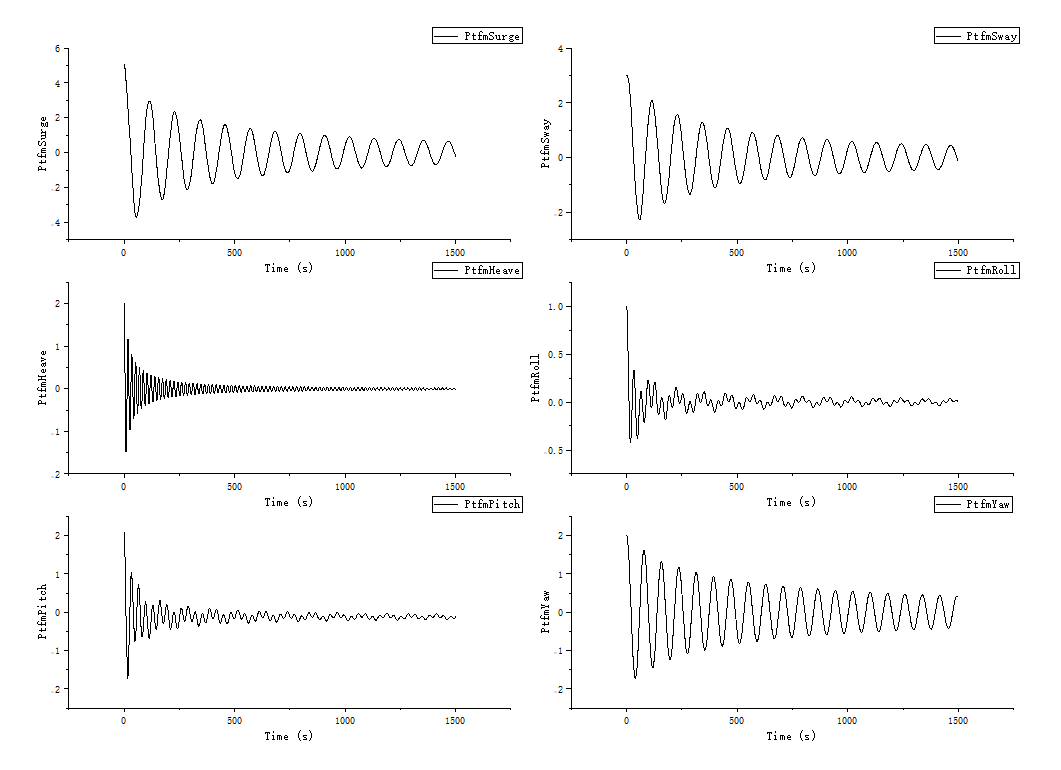Dear @Jason.Jonkman,
Thank you very much for your previous suggestions. I have recently revisited my model and made the following adjustments and verifications. Could you kindly confirm whether my current implementation is correct?
- Mass Matrix and Hydrodynamic Loads
I found the total mass matrix from a previous post as: M = [14070000 0 0 0 139200000 0; 0 14070000 0 139200000 0 -144800; 0 0 14070000 0 144800 0; 0 139200000 0 12700000000 -1.094E-01 1.167E+07; -1.392E+08 0 1.448E+05 -1.094E-01 1.269E+10 -1.953E+00; 0 -1.448E+05 0 1.167E+07 -1.953E+00 1.229E+10];
Is this mass matrix correct for the OC4 semi-submersible platform?
I have added the gravity term in my calculations.
For radiation forces, I subtracted them from the HydroFxi series (and corresponding moments). Is this the proper approach?
- Tower Base Reaction Loads
In our previous discussion, you mentioned that the floating platform also experiences reaction loads from the turbine through the tower (from ElastoDyn).
Are these reaction loads represented by:
TwrBsFxt, TwrBsFyt, TwrBsFzt, TwrBsMxt, TwrBsMyt, TwrBsMzt?
If not, which output channels should I use to account for these reaction loads properly?
- Platform Reference Frame
I aim to build the platform model centered at its center of mass.
In OpenFAST, I set PtfmCMxt, PtfmCMyt, and PtfmCMzt to 0 to achieve this.
Is this configuration correct for establishing a center-of-mass reference frame?
I greatly appreciate your time and expertise. Your guidance has been invaluable in improving my model implementation.
Best regards
Dear @Jason.Jonkman,
Thank you very much for your previous guidance—it has been extremely helpful to my work. I currently have two follow-up questions regarding my OpenFAST implementation:
- Free Decay Test for Pitch and Roll
When performing free decay tests, I noticed that the pitch and roll decay curves do not exhibit the expected behavior (i.e., they do not decay to zero), while the other degrees of freedom show correct decay patterns.
Could this be caused by incorrect configuration settings in OpenFAST?
Are there specific parameters or switches that I should verify to ensure proper free decay behavior for pitch and roll?
- Nacelle-Tower Interaction
I am currently modeling the nacelle and its internal components and would like to better understand how tower-top displacements affect the nacelle dynamics.
How does OpenFAST account for the influence of tower motion on the nacelle?
Are there any theoretical documents or references within the OpenFAST documentation that describe this coupling mechanism in detail?
I greatly appreciate your time and expertise. Your insights would be invaluable in helping me resolve these issues.
Thank you again for your support.
Dear @Shifeng.Jia,
Regarding (1), it looks like roll decays to zero, but the response is not a pure sinusoidal decay, likely because it is coupled with sway. Similar for pitch, which is likely coupled with surge, but does not decay to zero, likely because of the overhanging weight of the rotor-nacelle assembly that will result in a mean pitch offset.
Regarding (2), the nacelle motion is directly tied to the floater motion, tower deflection, and nacelle-yaw, if enabled. It sounds like you are asking about the kinematic and kinetics of the ElastoDyn equations of motion, which are documented here: 4.9. ElastoDyn Users Guide and Theory Manual — OpenFAST v4.0.5 documentation.
Best regards,
